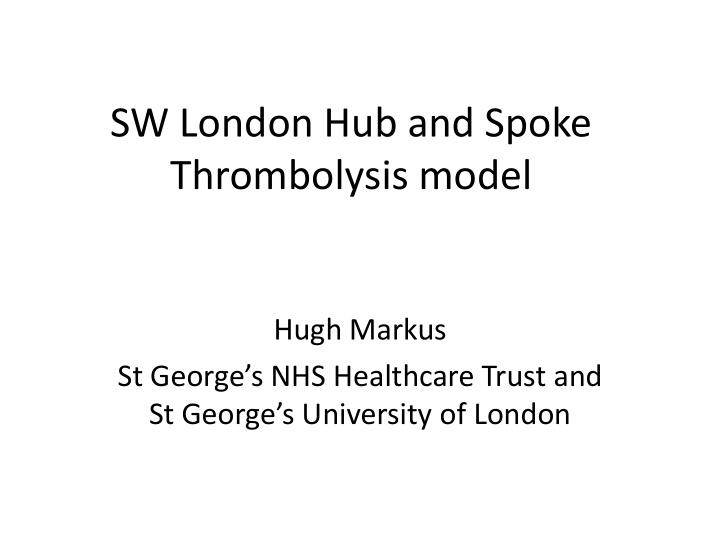



SW London Hub and Spoke Thrombolysis model Hugh Markus St George’s NHS Healthcare Trust and St George’s University of London
Sept 2007 24 hr local thrombolysis Feb 2009 Hub and spoke model introduced Hub and spoke model - Day time thrombolysis established at Mayday St Hellier Kingston - Out of hours thrombolysis via St George’s all weekend 17.00-9.00
Over 1 year - 771 patients admitted to SGH - 10% increase in admissions - 15% of all admissions “non - stroke” - Higher rate in regional referrals - 52% of regional patients from one of nominated spokes – rest not
No. of patients 0 1 2 3 4 5 6 7 8 9 Feb-08 No thrombolysed per month Mar-08 Apr-08 May-08 Jun-08 Jul-08 Aug-08 Sep-08 Oct-08 Nov-08 Dec-08 Jan-09 Daytime tPA rate Total Local
Dec Jan Hospital Feb Mar Apr May June July Aug Sep Oct Nov Total 1 St George’s 1 3 6 9 4 4 2 4 5 3 46 4 0 1 1 0 1 2 0 1 2 3 1 14 Kingston 2 1 2 Mayday 1 1 1 1 1 2 1 0 0 0 11 0 1 0 1 2 1 0 1 0 0 7 St Hellier 1 0 8 3 Total 3 6 7 12 9 7 4 7 7 4 78
Patient details - Mean age : - local 9-5 80 yr - Local out of hours 69.2 - Regional out of hours 72.5 - Male : - local 9-5 40% - Local out of hours 50% - Regional out of hours 56%
Patient details - Mean from stroke to A and E - local 9-5 82 +/- 23 min - Local out of hours 68 +/- 7 min - Regional out of hours 74 +/- 5 min
Door to needle The median time was 55 minutes with a range of 26 minutes to 2 hours 55 minutes and mean time of 61 minutes No difference for Regional or local patients - non-significantly lower for regional patients
6 month data 349 patients were admitted with possible stroke. 41% were regional patients. 77/349 were non-stroke diagnoses. 98/349 people met initial screening criteria for suitability for thrombolysis 68/98 were regional patients and 56/68 were assessed as part of the network 12/68 presented during normal working hours. 9/56 were non-stroke diagnoses. 27/98 patients were thrombolysed, of which 22 were regional diverts (1 was diverted during normal hours).
6 month data Of these 22 regional thrombolysed patients, 11 were discharged home, 3 died and 8 repatriated. Median delay to repatriation was 2 days (mean 2, range 1-7).
Patient feedback • The following conclusions were drawn from the study: – Overall patients and carers did not seem concerned about where patients received treatment, only that it was the best treatment available. – The additional travel caused by the patient’s admission to the hub hospital did not appear to have caused problems for family and friends. – Explanations given to patients at admission and transfer stages of the pathway could be improved. – Patients and carers were concerned about lengthy waits on the day of transfer back to the local hospital.
Positives - Thrombolysis available to patients who were not receiving it previously - Thrombolysis rates increased - Patients were happy with a regional service - Ambulance transfer times from DGHs were similar for SGH local and regional patients
Negatives - Ambulances found different referral practices at different times difficult - Some patients taken to hospitals when not offering thrombolysis – had to be re-transferred to SGH - Occasions where thrombolysis not available in DGHs during working hours - This resulted in suitable patients not being in right place to receive thrombolysis - Thrombolysis rates did not pick up as much as we would like
Conclusions - Hub and spoke was a good interim model - Thrombolysis more available than it was previously - Problems occurred with splitting day and out of hours service - Optimal configuration is to have all thrombolysis in 24/7 centres
Recommend
More recommend